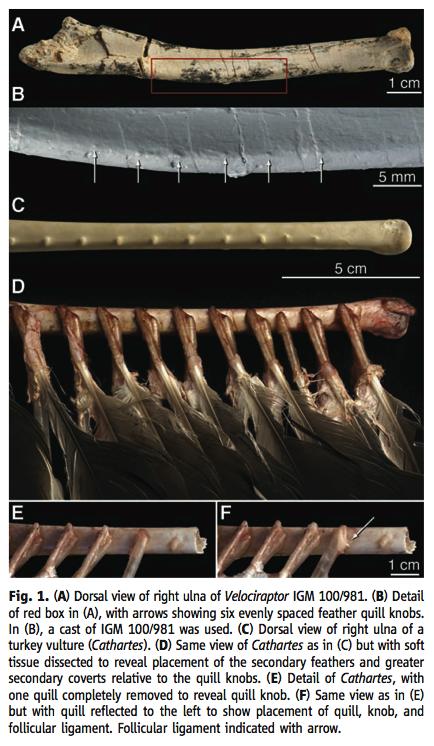tags: researchblogging.org, velociraptor, Dromaeosauridae, dinosaur, feathers, paleontology, evolution
Velociraptor skull.
Velociraptors were small dinosaurs, weighing only about 15kg and approximnately 1.5m long.
Image: M. Elison, AMNH. [larger view]
According to a research paper that was published late last week, the Velociraptor probably had feathers. A closer look at a fossil Velociraptor ulna (forearm) that was found in Mongolia in 1998 revealed a series of small bumps along its length. These bumps are known as "quill knobs" because they are found in most modern birds where they function as attachment points where secondary flight feathers are attached to the bone with ligaments. The quill knobs are especially prominent in strong fliers, while gliding birds and those that have lost the ability to fly either have reduced quill knobs or lack them altogether (Figure, below);
"A lack of quill knobs does not necessarily mean that a dinosaur did not have feathers," explained Alan Turner, from the American Museum of Natural History and Columbia University, New York City, and leader of the team. The presence of quill knobs indicates that the feathers were modern; comprised of a rachis and vanes that are formed by barbs.
"Finding quill knobs on Velociraptor, though, means that it definitely had feathers. This is something we'd long suspected, but no one had been able to prove," he added.
Even though the Mongolian Velociraptor's short arms suggest that this species was unable to fly; however, its feathers likely had other uses such as territorial or courtship displays, shielding nests, temperature control or to help the animal maintain its balance while running, the research team notes.
Velociraptor mongoliensis is classified into the family Dromaeosauridae, which comprises small to medium-sized, light and fast-running dinosaurs from the Cretaceous Period (146 million to 65 million years ago). The Dromaeosauridae appear to have been very effective predators, possessing a distinctive sickle-shaped claw on their second toe which was probably used to hang on to prey. The Mongolian Velociraptor featured in the AMNH/FMNH paper was small; weighing approximately 15kg and was only 1.5m long.
This collaborative study between the American Museum of Natural History in NYC and the Field Museum of Natural History in Chicago was published recently in the journal, Science.
Sources
"Feather Quill Knobs in the Dinosaur Velociraptor" by Alan H. Turner, Peter J. Makovicky and Mark A. Norell. Science 317:1721 (21 September 2007) [PDF] (images, quotes)
BBCNews (quotes)



I once heard of a hypothesis that dromaeosaurs like velociraptor are actually birds which became flightless. Is this currently thought likely?
Not 'birds' as such, because they're still probably outside the clade that's usually called that, but dromaeosaurs are reasonably likely to have had flying ancestors. A few basal small dromaeosaurs such as Microraptor, as well as some other small feathered dinosaurs, have reasonably well-developed 'wings' and could quite possibly fly to some extent (I say 'possibly' because there's a lot of argument about how much the earliest birds like Archaeopteryx and the feathered non-avian dinosaurs were powered fliers as opposed to gliders or such).
Cool!
I am waiting for the knobs to be found on T. rex arms...my pet theory is those itty bitty arms had feathers on them.
Clapping
Chardyspal
Unless I'm misreading this, the presence of quill knobs implies that feathers are attached to bone firmly enough for flight. I know it would be crazy to think that Velociraptor could fly, but what about a little lift to make it easier to use those claws on the hind legs? Could that be a scenario for the development of ground-up powered flight?